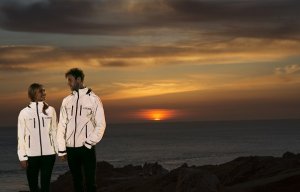
Proviz wins Amazon Growing Business Award
The high performance fabrics beloved of mountain sport enthusiasts are fast becoming a fixture on clothing racks. Their growing popularity is providing a boost for the Swiss textile industry. Growth in sales for the industry overall has been in the “double digits for the past few years,” explains Moritz Becher. He is editor at Outdoor Guide, Switzerland’s biggest alpine and outdoor sport magazine.

20th July 2012
Innovation in Textiles
|
Bern

The high performance fabrics beloved of mountain sport enthusiasts are fast becoming a fixture on clothing racks. Their growing popularity is providing a boost for the Swiss textile industry.
Growth in sales for the industry overall has been in the “double digits for the past few years,” explains Moritz Becher. He is editor at Outdoor Guide, Switzerland’s biggest alpine and outdoor sport magazine.
“Many brands don’t say it directly, but this growth is in large part thanks to the customers who are buying technical high alpine or exhibition jackets, sometimes as much as SFr800 ($839), although they don’t need that level of functionality,” Becher told swissinfo.ch.
As a result, the outdoor industry has been reaping the rewards. And according to the Swiss Textile Federation’s 2011 annual report, functional fabrics now account for more than 50 per cent of the country’s textile exports.
The textile and garments industry employed 14,800 people in Switzerland at the end of 2008, which was around 1,000 more than in the previous year.
“What we have [in Switzerland] is the know-how, the technology, and the innovative power to add value to the functional clothing sector,” said Aline Kloetzer, head of the organisation’s economic affairs and statistics department.
One Swiss company leveraging the versatility of its clothing’s functionality is Vingetorix.
Its “everyday jacket” - windproof, waterproof, breathable and made solely of EtaProof organic cotton - won a top award during last year’s Outdoor Trade Show in Friedrichshafen, Germany.
EtaProof is a high-tech cotton fabric originally developed for the flight suits worn by British pilots during the Second World War to keep them warm and dry should they have to be rescued from the freezing North Sea. Swiss textile specialists Stotz & Co further developed this fabric and began manufacturing it in the 1990s.
Vingetorix decided to create its own urban outdoor wear line last year because there was a “real demand”, explained product and sales manager Alicia Etienne.
“We observed a need for a functional jacket, that could be used to go hiking on the weekend, but still looks very decent to go to the office on Monday.”
Icebreaker, a New Zealand brand which arrived in Switzerland in 1999, is one of the better-known crossover labels. Its minimalist merino wool apparel was destined for both mountain and street wear from the start.
“After wearing one of these shirts for three weeks in a row without washing it, only airing it out in the wind once in a while, it didn’t stink,” said Janosh Conte, a climber who works at a Bächli sporting goods store in Basel.
Icebreaker Switzerland said their clothes “seamlessly transition” into casual wear, including “travelling, relaxing, or even working”.
Anyone travelling by public transport in Switzerland would not fail to notice the recent popularity among commuters of jackets and fleece carrying the Mammut label.
Mammut, the 150-year-old Swiss mountain apparel and gear company, appreciates the street popularity of its clothing, but says it has not abandoned its allegiance to the mountaineers their goods are made for.
“Of course we are aware of the trend, and we don’t want to miss the boat, but even if some people buy our jackets to walk the dog, we won’t produce jackets that are solely made for the urban environment,” Harald Schreiber, public relations manager of Mammut, told swissinfo.ch
Mammut’s clothing range is more profitable than its outdoor gear such as climbing ropes and helmets, and represents two-thirds of its worldwide sales.
Although the average dog walker may not need the same functions as a climber making his way up a crag in a mix of weather conditions, they still make life more comfortable. Schreiber thinks that beyond the additional comfort and weather protection, there’s also something to be said for brand identification.
“I think that for some people, it’s about presenting a certain image. Wearing one of our jackets states that you belong to a group of people who are active, and maybe even daring,” he said.
By Rachel Marusak Hermann
Article republished with the kind permission of www.swissinfo.ch

Business intelligence for the fibre, textiles and apparel industries: technologies, innovations, markets, investments, trade policy, sourcing, strategy...
Find out more